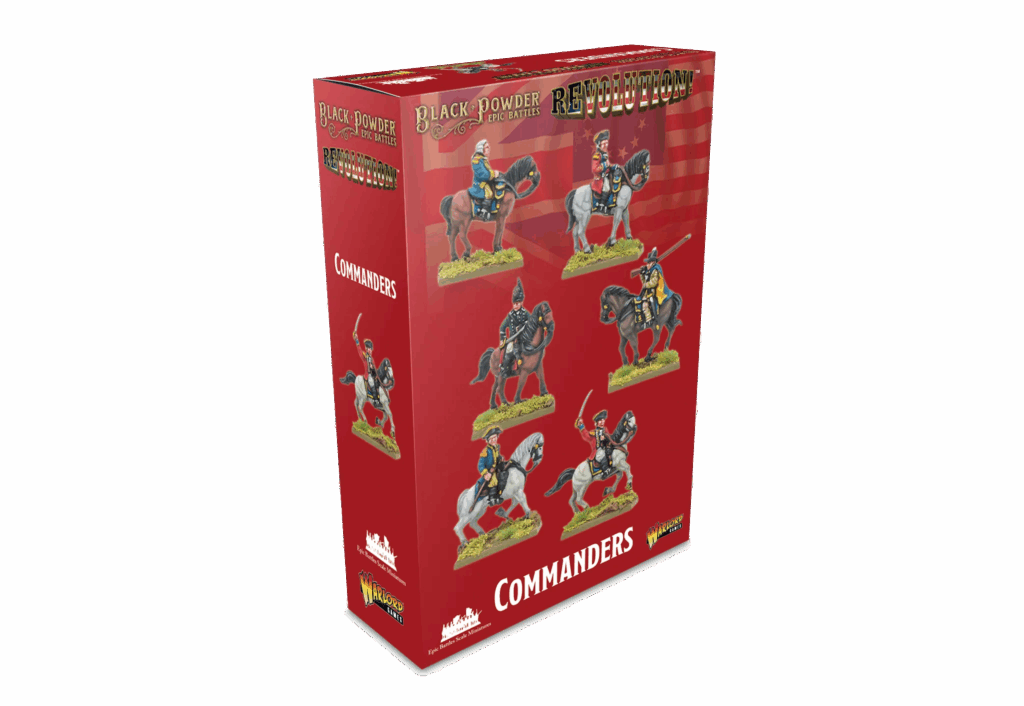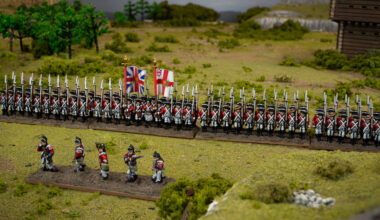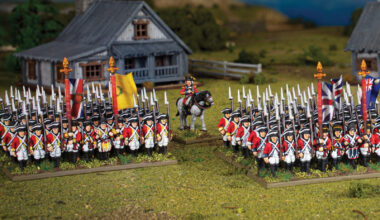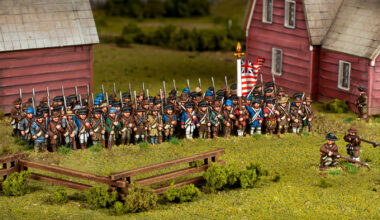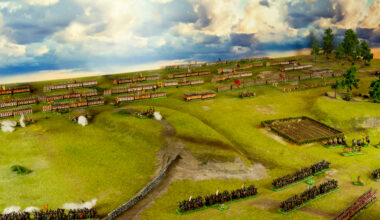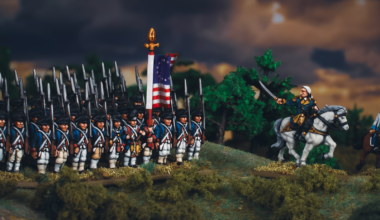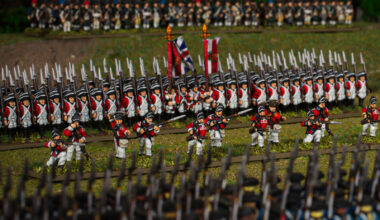Black Powder Epic Battles: Revolution! is out now, and we’re taking a look at some of the key personalities who commanded the troops in battle. Last week, we looked at the British, and today it’s the turn of the Americans. Two of these chaps can be found in the handy Commanders boxed set, while the third comes as a special figure in the main starter box.
Morgan
We’ll kick off proceedings with Colonel Daniel Morgan, one of the most respected American tactical leaders, and the terror of many a British officer. Born in New Jersey, he would settle in Virginia, and serve as a civilian teamster and waggoner for the British during the French & Indian Wars, where he would be flogged (allegedly for striking an officer) – this gave him a rather understandable dislike for the British and their methods! He would later serve as a rifleman in the provincial forces, and by the outbreak of the Revolution had settled down to life as a reasonably successful farmer and family man.
At the start of the war, Morgan raised a company of riflemen from Virginia, equipped with ‘long rifles’ and trained as sharpshooters. These men were experts at long-range shooting, and became the bane of British officers. Morgan would command a battalion in Benedict Arnold’s invasion of Canada, being taken prisoner at Quebec. He would spend a year in British captivity, before being exchanged. Returning to America, Morgan was surprised to learn that he had been promoted to Colonel for his service, and would be given command of a new regiment, alongside the Provisional Rifle Corps, nicknamed ‘Morgan’s Rifles’.
Morgan would lead his men well in Saratoga, but was becoming disgruntled with being repeatedly passed over for promotion in favour of better-connected men. In June 1779 he resigned his commission, but would return to service in 1780 under Greene in the southern colonies. He finally received his desired promotion to Brigadier General later that year, and would be sent with his men to harass and skirmish with the British in South Carolina, avoiding direct confrontations. However, when the British commander Cornwallis sent the infamous Banastre Tarleton after him, Morgan would go against his orders, and provoked an open battle in January 1781.
The resultant Battle of Cowpens would be Morgan’s finest hour. Exploiting Tarleton’s overconfidence, he won a famous victory and essentially knocked Tarleton’s feared British Legion out of the conflict, depriving Cornwallis’ forces of their manoeuvrability and speed. Cowpens would also be Morgan’s last major engagement. Suffering from ill health, exacerbated by conditions on campaign, he once more returned to his farm in Virginia, only briefly returning to the fight that July as part of Lafayette’s inconclusive pursuit of the British in Virginia.
In Black Powder, we represent Morgan’s tactical prowess and hard-won experience with a Staff Rating of 9, making him one of the best commanders available to American forces. In addition, his experience raising and leading militia units allows him to boost their effectiveness. Militia units within 3” of Morgan can re-roll any failed Break test, making them more likely to stay in the fight.
Gates
Major-General Horatio Gates was one of the most controversial American commanders of the Revolution, both in his own lifetime, and historically. An Englishman who had seen service in the British Army during the Seven Years’ War in both Europe and America, at one point alongside George Washington, he had sold his commission out of frustration at his inability to progress through the ranks. Purchasing a plantation in Virginia, he settled into life in America, and would become increasingly sympathetic to the cause of colonial freedom.
When the Revolution began, Gates volunteered for service, and at Washington’s urging was commissioned as a Brigadier-General, and appointed as the first adjutant general of the Continental Army. In this vital organisational role, his prior experience in British service proved invaluable, and he provided a great deal of foundational organisation to the fledgling force. However, Gates yearned for a field command, and thought that he, not Washington, should be the overall commander. He spent much energy attempting to convince Congress of this, but Washington’s war record cemented his position at the top.
By 1777, Gates had succeeded in securing a field command, taking over from Phillip Schuyler as commander of the Northern Department. In this capacity, he commanded the crushing victory over Burgoyne’s forces at Saratoga, being lauded as a hero – a fact that he was quick to attempt to capitalise on. In reality, the majority of the credit belonged to Gates’ subordinates, but Gates himself saw the opportunity once more to leverage his rising stock to replace Washington. A political scandal ensued, and Gates was forced to apologise and accept Washington’s command.
In 1780, Gates would be sent to command the Southern Department, following Benjamin Lincoln’s surrender at Charleston. Here, his weakness as a commander was swiftly exposed. Unwilling to listen to more experienced advice, Gates rushed his troops – underfed and suffering from sickness – into battle with Cornwallis’ forces at Camden. The battle was a disaster, and the American forces were routed. Gates himself fled from the field with extraordinary haste, and this act compounded with his defeat to utterly ruin his military reputation. He would never again hold a field command.
For those players who like a challenge, Gates is a fantastic opportunity to field a commander who is more of a hindrance than a help. With a Staff Rating of 7 and the Timid rule, if you can win with Gates, then you are a truly gifted leader!
Washington
We’ve saved the best (and certainly the best-known) ‘til last. George Washington would of course go on to serve as the first President of the United States, following his time as the commander of the Continental Army, but before this he was a Virginia-born militia officer in British service! A regimental commander during the French and Indian Wars, Washington would see mixed success on the field, but gained vital experience in leadership and organisation that would stand him in good stead during the Revolution.
When the Revolution broke out, Washington was appointed by Congress to command the new Continental Army. Setting about transforming it from an ill-trained rabble to a more professional, disciplined force, Washington saw success when the British evacuated Boston, but would subsequently be defeated by Howe in New York forced to retreat through New Jersey. In the bitter winter of 1776, however, Washington led his men in an audacious crossing of the frozen Delaware river, and won a pair of stunning victories at Trenton and Princeton. These victories boosted American morale enormously at a time when it was desperately needed.
Interestingly, Washington would suffer more defeats than he won victories as a commander during the American Revolution. However, the greatest skill that he brought to the cause was not tactics or strategy – rather, it was inspirational leadership, and his ability to achieve the almost impossible task of maintaining an army in the field throughout the long years of the conflict. Simply by never giving in, and never being forced to surrender, he demonstrated to the British that the Colonies simply could not be held by force.
His final victory at Yorktown in October 1781 cemented the American victory. At the head of a combined French and Continental force, Washington made his ‘celebrated march’ into Virginia, trapping Cornwallis in Yorktown and forcing him to surrender. While a formal peace would not be negotiated for another two years, Yorktown would be the last major engagement of the Revolution, and the final ‘encouragement’ the Crown needed to cease hostilities. Washington would leave the army in 1783, but his standing was such that, when the newly constituted United States required a man to lead it, he was the only man to which it could turn.
On the tabletop, Washington will always serve as the General of any Continental Army including him. Handily, you can get hold of him for free when you order the Revolution! battle-set from the Warlord Games Webstore, ensuring no-one need go without him! When he provides re-rolls to brigade commanders, his Staff Rating is used instead of theirs – he’s the commander in chief, after all. Interestingly his Staff Rating is actually randomly generated, to represent his mixed war record – but it’s never a bad choice to include the boss himself!
Want to include these commanders (and their British & Hessian counterparts) in your Epic Battles: Revolution! collection? Of course you do! Luckily, they’re all included in one handy boxed set (with the exception of Washington), giving you a great choice of historical personalities to lead your troops into battle.
